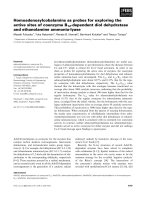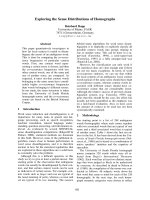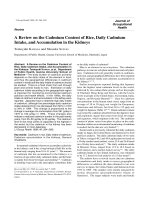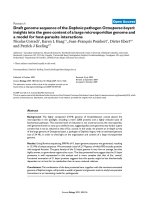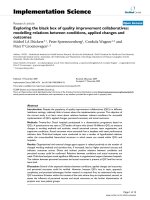- Trang chủ >>
- Cao đẳng - Đại học >>
- Luật
EXPLORING THE LEGAL CONTENT OF ERIN BROCKOVICH (2000) THROUGH AN ANALYSIS OF ITS LITERARY ELEMENTS
Bạn đang xem bản rút gọn của tài liệu. Xem và tải ngay bản đầy đủ của tài liệu tại đây (1.04 MB, 58 trang )
MINISTRY OF EDUCATION AND TRAINING
HO CHI MINH CITY UNIVERSITY OF LAW
GRADUATION THESIS
B.A. DEGREE IN ENGLISH
Major: Legal English
EXPLORING THE LEGAL CONTENT OF "ERIN BROCKOVICH" (2000)
THROUGH AN ANALYSIS OF ITS LITERARY ELEMENTS
Supervisor: Tran Ngoc Luong Tuyen, M.A.
Student: Nguyen Ngoc Minh Trang
Student ID: 1652202010064
Class: LE41
Ho Chi Minh City, 2020
Legal Content of “Erin Brockovich”
Nguyen Ngoc Minh Trang
Ho Chi Minh City University of Law
SUPERVISOR’S REMARKS
iii
ACKNOWLEDGMENT
I owe a great deal to every individual whose support for me and this thesis is too
numerous to name. Without them, this thesis would not have completed.
I would like to express my sincere gratitude to my thesis supervisor, Mrs. Tran
Ngoc Luong Tuyen, for her guidance throughout the journey. She has allowed my
creativity to be flourished within this paper but also oriented me in the right direction
whenever I found myself lost by giving valuable guidelines and recommendations.
I would also like to pay my special regards to Mrs. Pham Thi Thuy Dung for her
counsel at the beginning of this journey. Her inspired lectures in English literature
made a strong impression on me and embarked on me to take the path.
Again, I would like to show my gratitude to Mrs. Le Thi Xuan Thu for her
supportive answers to all my questions regarding this issue, and to her dedication to
our class for the previous four years. I would like to extend my attitude of appreciation
to all the members in the Department of Legal English for their support during the
whole course.
I also send my appreciation to my friends for their valuable friendships during my
time at ULAW. Especially helpful to me during the time this thesis was carried on
were Nguyen Ngoc Huynh Anh and Vo Minh Nga with their valuable support and
insightful suggestions, Vo Thi Thu Lien with her practical materials, and Ngo Kim
Thanh with her generous advice.
I am indebted to my family, none of this could have happened without them,
especially my mother, for her unconditional love and encouragement.
I am extremely grateful to all!
Ho Chi Minh City, June 2020
Nguyen Ngoc Minh Trang
iv
LIST OF ABBREVIATIONS
Abbreviations
Explanation
AAA
American Arbitration Association
ABA
American Bar Association
CCP
California Code of Civil Procedure
Cr(III)
Trivalent chromium or chromium 3
Cr(VI)
Hexavalent chromium or chromium 6
CRC
California Rule of Court
FRCP
Federal Rules of Civil Procedure
LRWQB
Lahontan Regional Water Quality Control Board
PG&E
Pacific Gas & Electric
U.S.
United States
v
LIST OF TABLES
Table 1: Basic camera angles ....................................... Error! Bookmark not defined.
Table 2: Most popular film genres ..................................................................................7
Table 3: Types of characters .........................................................................................10
Table 4: Basic points of view ........................................................................................11
Table 5: Hinkley's groundwater contamination historical summary ............................20
Table 6: Main characters ..............................................................................................25
Table 7: Minor characters ............................................................................................26
Table 8: Statute of Limitations ......................................................................................30
Table 9: Summary of findings .......................................................................................42
vi
LIST OF FIGURES
Figure 1: Illustration of the three-point lighting .......... Error! Bookmark not defined.
Figure 2: Model of Freytag's pyramid ............................................................................9
Figure 3: Steven Soderbergh ........................................................................................16
Figure 4: The real Erin Brockovich ..............................................................................18
vii
TABLE OF CONTENTS
SUPERVISOR‟S REMARKS .......................................................................................... iii
ACKNOWLEDGMENT .................................................................................................. iv
LIST OF ABBREVIATIONS ............................................................................................ v
LIST OF TABLES ........................................................................................................... vi
LIST OF FIGURES ........................................................................................................vii
TABLE OF CONTENTS .............................................................................................. viii
INTRODUCTION ..........................................................................................................1
I. BACKGROUND TO THE STUDY ......................................................................1
II. OBJECTIVES OF THE STUDY .........................................................................2
III. NECESSITY OF THE STUDY ..........................................................................2
IV. SUBJECT AND SCOPE OF THE STUDY .......................................................3
V. RESEARCH METHODOLOGY ........................................................................3
V.1. Methodological approach .................................................................................3
V.2. Data ...................................................................................................................4
V.2.1 Data collection .............................................................................................4
V.2.2 Data processing ...........................................................................................4
V.2.3 Data analysis ................................................................................................4
VI. STRUCTURE OF THE THESIS .......................................................................5
CHAPTER ONE. LITERATURE REVIEW .................................................................6
I. HOLLYWOOD FILM AND ITS ELEMENTS (MODEL FOR FILMS
ANALYSIS) ................................................................................................................6
I.1. Hollywood film ..................................................................................................6
I.2. Cinematography ............................................... Error! Bookmark not defined.
I.2.1. The camera ................................................. Error! Bookmark not defined.
I.2.1.1 Camera angles....................................... Error! Bookmark not defined.
I.2.1.2 Camera movements .............................. Error! Bookmark not defined.
I.2.2. Lighting effect ............................................ Error! Bookmark not defined.
I.3. Sound effect ...................................................... Error! Bookmark not defined.
I.4. Film genres .........................................................................................................7
viii
I.5. Literary elements ................................................................................................8
I.5.1. Plot ...............................................................................................................8
I.5.2. Setting ..........................................................................................................9
I.5.3. Characterization .........................................................................................10
I.5.4. Symbolism .................................................................................................10
I.5.5. Point of view ..............................................................................................11
I.5.6. Theme.........................................................................................................12
II. LITERARY APPROACHES .............................................................................12
III. “LAW-IN-LITERATURE” AND “LAW-AS-LITERATURE”
APPROACHES ........................................................................................................13
IV. OVERVIEW OF THE LAW OF CALIFORNIA ...........................................13
V. SUMMARY OF CHAPTER ONE .....................................................................14
CHAPTER TWO. LITERARY ANALYSIS .................................................................16
I. BACKGROUND INFORMATION ....................................................................16
I.1. ―Erin Brockovich‖ and Steven Soderbergh ......................................................16
I.2. The stories behind the movie............................................................................18
I.2.1. Erin Brockovich .........................................................................................18
I.2.2. Hinkley ground water contamination.........................................................19
I.2.2.1 Historical summary...............................................................................19
I.2.2.2 Litigation ..............................................................................................20
II. LITERARY ANALYSIS ....................................................................................22
II.1. Plot ..................................................................................................................22
II.1.1. Plot summary ............................................................................................22
II.1.2. Plot analysis ..............................................................................................23
II.2. Setting .............................................................................................................24
II.3. Characterization ..............................................................................................24
II.3.1. Main characters .........................................................................................24
II.3.2. Minor characters .......................................................................................25
II.4. Symbolism.......................................................................................................26
II.5. Point of view ...................................................................................................26
II.6. Theme ..............................................................................................................27
III. SUMMARY OF CHAPTER TWO ..................................................................28
ix
CHAPTER THREE. LEGAL CONTENT ...................................................................29
I. LEGAL TERMS ...................................................................................................29
I.1. Statute of limitations ........................................................................................29
I.2. Binding arbitration ...........................................................................................30
I.3. Demurrer...........................................................................................................31
II. COMMENCING A CLASS ACTION LAWSUIT ..........................................34
III. FEE SPLITTING WITH NON-LAWYERS...................................................37
IV. SUMMARY OF CHAPTER THREE ..............................................................39
CONCLUSION .............................................................................................................40
I. SUMMARY OF THE FINDINGS ......................................................................40
II. LIMITATIONS OF THE STUDY ....................................................................42
III. RECOMMENDATIONS FOR FURTHER STUDIES ..................................43
BIBLIOGRAPHY ........................................................................................................... xi
BOOKS ...................................................................................................................... xi
DICTIONARIES ....................................................................................................... xii
DIGITAL IMAGES .................................................................................................. xii
FILM ........................................................................................................................ xiii
JOURNAL ARTICLES ........................................................................................... xiii
LEGISLATION........................................................................................................ xiii
SCRIPT .................................................................................................................... xiii
THESES ................................................................................................................... xiii
WEBSITES/WEB BLOG ........................................................................................ xiv
x
INTRODUCTION
This part basically covers the primary information of the study, including the
background to the study, which provides context to the whole study. It also
encompasses the objectives and the necessity of the study, the subject, and the scope of
the study as well as the research methodology in use and the structure of this thesis.
I. BACKGROUND TO THE STUDY
Law and film have been identified as the two distinct major fields. However, for a
long time, the combination of these two have been already marked with the
tremendous number of films contain legal matters, including Twelve Angry Men
(1957), To Kill A Mocking Bird (1962) whose plot is based on the novel of the same
name of Harper Lee, A Civil Action (1998), Michael Clayton (2007) and Conviction
(2010). Apparently, there has been a considerable development in the number of
law-centric movies in Hollywood from the 20th century to the 21st century. The
simultaneous movement of law and cinema has resulted in the legal storytelling on the
widescreen, where the topic of law plays the backbone role of the plot.
As the effect of the waves of law-centric movies in the late 20th century, scholars
with different backgrounds have been attracted to the subject. So far, the topic of law
and film has been under investigated and it has been written by many academics. The
interdisciplinary research between law and film is by no means new. It is not
surprising that there is no consensus regarding the subject matter nor the way of
conducting such researches. Therefore, a variety of approaches has been used to
scrutinize legal films. These methods may provide rich insights into the functions of
the film as an artistic work and into the sociopolitical environment. 1 One of the most
well-known concepts addressing the issue that is earlier recognized by some legal
scholars, is the association of ―law and literature‖. In New Direction in Law and
1
C.J.S. Picart, M.H. Jacobsen and C. Greek (eds.), Framing Law and Crime: An
Interdisciplinary Anthology, Maryland, Fairleigh Dickinson University Press/ Rowman and
Littlefield Publishing, 2016, p. 27.
1
Literature, (Anker and Meyler, 2017) recognized the law and literature as a joint
discipline in certain aspects because both fields of study based on the study of rhetoric,
which focuses on the views of language and social context.2 Although (Black, 1999)
claimed that ―Much of legal writing about film has identified itself, in one way or
another, with legal writing on literature,3‖ ―law and literature‖, to some certain extent,
has laid the groundwork for law and film.4
In respect of films on law, the ways at which academics have approached the
depiction of the legal content in such movies are quite diverse. Some believe that the
application of motion pictures in legal storytelling may be more complex and more
open to interpretation than the effect of a legal text.5 Therefore, some have used film
related to law as a tool in legal education even though the portrayal of the legal
institutions in such movies cannot be exactly as same as reality. It is regarded that the
legal content of these films still accentuates certain aspects. In such event, the film
Erin Brockovich, which was produced in 2000, is taken into account to uncover the
legal content of it through certain approaches in the field, as well as to introduce some
basic aspects in approaching film analysis.
II. OBJECTIVES OF THE STUDY
Firstly, the study intends to examine the literary elements through the script of the
movie, and secondly, to explore the legal content depicts from such, by applying some
specific approaches in ―law and literature‖, including literary approaches.
III. NECESSITY OF THE STUDY
The first time when films were used in the law school classrooms still remains
unknown, but it is hard to deny its widespread practice. The use of audio-visual
2
E. Anker and B. Meyler (eds.), New Directions in Law and Literature, USA, Oxford
University Press, 2017, p. 1.
3
D. Black, Law in Film: Resonance and Representation, Urbana and Chicago, University of
Illinois Press, 1999, p.117.
4
Picart, Jacobsen and Greek, Framing Law and Crime, p. 27.
5
Picart, Jacobsen and Greek, p. 43.
2
materials, including law-related films in education, has already been familiarized with
law students and law teachers between the 20th and 21st centuries. Legal films, by
degrees, have become an effective tool for the public to access some fundamental
aspects of the legal system in a less academic approach. As mentioned before, the
depiction of law in a film does not one hundred percent correctly, but it does
accentuate some aspects of the reality. Therefore, with academics from different
backgrounds, newcomers to the legal field, people without legal based or even law
students who want to have a visual and non-theoretical approach to a foreign legal
system, the law-related film is one option. This research is carried out with the hope
that its findings will become a practical source of reference for those who want to
study law without a purely academic approach based on the legal content taken from
the movie Erin Brockovich. The results of this study are expected to be a practical
material for teaching and learning Legal Terminology and Legal Ethics, as well as to
enrich the movement of film, literature and law.
IV. SUBJECT AND SCOPE OF THE STUDY
The study centralizes the film Erin Brockovich (2000) directed by Steven
Soderbergh and written by Susannah Grant.
The coverage of this study is limited to within the script of the film in literary text
and some issue related to the law of the United States (―U.S.‖), specifically in
California.
V. RESEARCH METHODOLOGY
V.1. Methodological approach
The purpose of the study, as aforesaid, is to interpret and have thoroughly intuition
into the legal issues sketching out from the film Erin Brockovich by scrutinizing its
literary elements. In order to answer such research questions, qualitative research is
implemented as the most suitable method for this type of research.
3
Qualitative research, as defined by Punch (2014), ―is empirical research where the
data are not in the form of numbers6‖. This approach appears to be the standard
approach to theoretical researches without static numbers or charts that are similar to
this thesis.
V.2. Data
The two types of data used in this thesis are primary and secondary data.
The primary data is the movie Erin Brockovich (2000) itself as well as some legal
texts.
The secondary data includes some academic books, online blogs, and the movie‘s
script, which was written by Susannah Grant.
V.2.1 Data collection
Data was collected from a wide spectrum of sources, varying from the local major
libraries to online reliable sources, and it was carefully selected in accordance with the
subject and the scope of this study.
V.2.2 Data processing
The data was then organized and compared to find the eligible information for the
thesis, before being divided into clusters based on their content to prepare for the next
steps.
V.2.3 Data analysis
After the information was clustered, it was reselected and textual analysis is
conducted. The next chapter will provide the scope of certain approaches that can be
applied in this research to acquire intuition about the movie.
In addition, the legal content of the movie is identified through the information
depicted in the movie and the script. Then, these contents will be explained and
analyzed in more detail with the legal resources gathering from the local libraries and
online websites.
6
K. Punch, Introduction to Social Research: Quantitative and Qualitative Approaches, 3rd edn,
London, Sage, 2014, p. 3.
4
VI. STRUCTURE OF THE THESIS
The thesis is in three chapters, which is not inclusive of the introductory part and
the conclusion.
Chapter One. Literature Review: in this chapter, some theories and concepts related
to the study will be introduced.
Chapter Two. The movie “Erin Brockovich”: this chapter will concentrate on the
film and its analysis using literary approaches.
Chapter Three. Legal Content: the final chapter will discuss the legal content depicts
from the film and some legal institution aspects in reality.
5
CHAPTER ONE. LITERATURE REVIEW
This chapter discusses several theories ranging from general views regarding the law
of California to critical approaches to the field of law-and-film that can be employed
in this study.
I. FILM AND ITS ELEMENTS
Understanding the elements constructing a film, especially with legal films, may
provide insights into the legal issue conveyed in the movie. This means getting the
―film‖ out of the ―law-and-film scholarship‖ for scrutinizing its characteristics by
employing the approach of film analysis. However, regardless of the scope of this
thesis, only a part of the elements constructing a film will be presented in this part.
I.1. Film
A ―film‖ is ―a series of moving pictures, usually shown in a cinema or on
television and often telling a story7‖. Although the birth of film is undefined, some
may consider the first public film-show of the Lumière brothers which marked the
development of the motion pictures in storytelling, is the day the first film is born.
Since then, the world of film is continuously moving and improving.
―Hollywood‖, the first word instantly springs to mind of the majority whenever
someone mentioned about the U.S. film industry or American films, shows how the
American film-making industry booming for the last centuries. The popularity of
American movies is undeniable with excellent blockbusters that bring parts of
American to the world. Of course, that is not only what movies can do. A movie is a
means of entertainment, a tool of education, a medium of communication and beyond
all of those meanings, a movie is a piece of art.
Generally, an art is created by a combination of diverse elements. The same goes
for a film. There are various factors influencing the success of a movie. Nonetheless,
in accordance with the scope of this study, only the film genres and the literary
elements are presented in this part.
7
‗Film‘, Cambridge Advanced Learner's Dictionary & Thesaurus,
(accessed 1 March 2020).
6
I.2. Film genres
Genre is a category in which films are sorted based on the literary elements 8 and
the content. Knowing the film-genres provides a basic overview of the movie content
and shapes the plotline. A sub-genre is a term described as a smaller category of a
genre and can be a combination of two or more genres.
Genres
Action
Animation
Comedy
Drama
Fantasy
Romance
Sub-genres
Short descriptions
Examples
Adventure,
Defined by risk and stakes such as
Iron Man
disaster, etc.
fight scenes or stunts.
Traditional, stop
Defined by living inanimate
motion, etc.
objects.
Sitcom, satire,
Defined by humorous events, even
prank, etc.
if the story is droll.
Melodrama,
Defined by conflict, and often
legal drama, etc.
looks to reality.
Contemporary
Defined by both circumstance and
fantasy, dark
setting inside a fictional,
fantasy, etc.
unrealistic universe.
Period-romance,
Defined by close relationships.
etc.
(2008)
Frozen (2013)
Rush Hour
(1998)
Silence (2013)
Harry Potter
(2001)
Jane Eyre
(2011)
Science
Utopian,
Defined by a mixture of
Tomorrowland
fiction
steampunk, etc.
speculation and science.
(2015)
Table 1: Most popular film genres
Besides the film genres listing in the table9 above, there are others including
historical, horror, western, thriller, musical, etc.
8
Literary elements will be analyzed in the next sub-section (sub-section I.5.).
Information in the table is retrieved from S. Lannom, ‗Ultimate Guide to Movie
Genres — 90+ Genre Examples for Film & TV‘, StudioBinder, [web blog], 9
September 2019, (accessed 2
March 2020).
9
7
I.3. Literary elements
A film is a way of narrative through motion pictures based on the written text of its
script. When considering a movie script in a literary context, it is quite similar to
interpret a fiction, as both forms of narrative shares certain similarities. This part
discusses each of the literary elements of a fiction, which is used in literary analysis.
Sub-section I.5. also provide a model for the analysis of the literary text of a film,
which based on the model of literary analysis.
I.3.1. Plot
Usually, people can use interchangeably between the two words plot and story.
However, in literary studies, these are slightly different. The story is a narrative of the
events presenting in chronological order, whereas the plot is also a narrative of the
events except that it shows a relationship of cause and effect.10
Basically, the plot has five main elements, based on the typical pattern called the
"Freytag's pyramid", which developed by a German playwright - Gustav Freytag in the
19th century.
There are five main elements in the Freytag‘s pyramid. Firstly, the exposition is
the beginning of the story, which introduces the setting and the characters of the story.
It also provides hints or even establishes the future conflicts which lead to the second
element, the rising action. At this stage, the conflict becomes more dramatics, and
creates suspense. The most exciting part of the story is the climax, which is the turning
point of the plot, where the conflicts reach the peak. After that, the plot moves onto the
fourth elements, the falling action. At this point, the tensions are eased down and it
reflects the way the main characters handle the conflicts. The final element is the
10
K. Griffith, Writing Essays about Literature: A Guide and Style Sheet, 8th edn,
Boston, Wadsworth Cengage Learning, 2011, p. 51.
8
resolution. This is the end of the story, sometimes, it may come up with a plot twist. 11
The figure12 below exemplifies this structure:
Figure 1: Model of Freytag's pyramid
In term of the conflict in literature, it is divided into two types: internal conflict
and external conflict. While internal conflict is the struggle inside the character‘s mind,
external conflict refers to struggle between a character with outside forces like the
environment around, the nature or another character.13
Despite of the Freytag's pyramid pattern, there are other plot patterns. A work may
have muted conflicts, unresolved conflicts, open endings or have no climax at all. It
may also have multiple plot lines which are the linkage of cause and effect of a chain
of events.14
I.3.2. Setting
A setting of fiction is where and when the story is set. To many people, this
element is similar to the term ―mise-en-scène‖ in film production, which is the
11
Retrieved from Literary Devices, [website], />(accessed 2 March 2020).
12
The original picture is taken from S. Lannom, ‗What Is a Plot? Types of Plot,
Definitions, and Examples‘, StudioBinder, [web blog], 21 August 2019,
(accessed 2 March 2020).
13
Griffith, Writing Essays about Literature, p. 55.
14
Griffith, p. 53.
9
arrangement of the background behind a camera. There are three elements that can be
analyzed in the setting: the social environment, the place, and the time or the historical
context of the story. There are two primary types of setting: the backdrop setting and
the integral setting. The latter influences the other elements of the story like themes or
characters, but the former is opposite, caused it is difficult to identify the (historical)
time of the story with the backdrop setting as it can be timeless15.
I.3.3. Characterization
Characterization is a literary device which used to depict a character. There are six
main types of character which are presented in the table16 below.
Types of character
Protagonist
Antagonist
Short descriptions
Main character in a story; conflicts with the antagonist.
Opponent of the protagonist; can be a person, an inanimate
object, an animal, etc.
Dynamic character
Changes during the course of a novel or a story.
Static character
Remains the same throughout the whole story.
Round character
A complex type of character with different personalities.
Flat character
Usually has one or two personality traits; remains unchanged
throughout the story.
Table 2: Types of characters
I.3.4. Symbolism
Symbolism is the utilization of symbols as a literary device, by symbolizing an
object, person, or situation with something different from their literal sense like an
idea or a thought. For example, in the film The Great Gatsby (2013) based on the
original 1925 novel of the same name of F. Scott Fitzgerald, the name Daisy has a
symbolic meaning. Daisy is the name of a flower that has a yellow center and white
petals surrounded. While the white parts represented for innocence, purity, the yellow
one stands for deceit. It is similar to the character Daisy in such a work, who appears
15
Retrieved from Literary Devices, [website], />(accessed 2 March 2020).
16
Information in the table is retrieved from Literary Devices, [website],
(accessed 2 March 2020).
10
to be innocent, but her inner is filled with corruption and greed. She lets Gatsby
believe that she really loves him and will do anything with him, including leaving her
husband, but it is finally revealed that money is all she cares about. Symbols enable
authors to freely transfer an idea or a message within an attractive scope of a narrative.
It evokes the curiosity of readers or the audiences in the plot of the story and gives
universality to the characters and the themes of a piece of literature.17
I.3.5. Point of view
Point of view is the literature term describes the perspective of the narrator toward
the world of the work. Four basic points of view are introduced in the table below18.
Points of view
Third-person
omniscient
Short descriptions
Examples (novels)
The narrator is the all-knowing outsider; tells
Hawthorne‘s “The
the story from outside the world of the story;
Scarlet Letter”
has complete knowledge of all characters‘
(1850)
The
narrator
is an etc.
outsider; tells the story
thoughts,
actions,
Third-person
limited
from outside the world of the story; has
limited knowledge on one character‘s
thoughts, actions, etc.
The narrator refers to the characters in the
Third-person
third person; has omniscient knowledge
James Joyce‘s
“Araby” (1914)
Ernest
Hemingway‘s
objective
about the events, places, time except for the
(dramatic)
“Hill Like White
characters‘ thoughts unless it is revealed by
Elephants” (1927)
the characters themselves.
The story is told under the view of one
Fitzgerald‘s “The
First-person
point of view
character in the story, using the first-person
pronoun ―I‖.
Great Gatsby”
(1925)
Table 3: Basic points of view
17
Retrieved from Literary Devices, [website], />(accessed 2 March 2020).
18
Information in the table is retrieved from Griffith, Writing Essays about Literature,
pp. 45-46.
11
I.3.6. Theme
A theme is the main idea of the work or an underlying message that the author
wants to transfer to the readers. In some complex works, there is more than one theme,
which can be divided into two types: major theme, which usually refers to as the
significant message of the work, and the minor theme, which is a less important theme
that appears beside the major one. For instance, the major theme of Frozen (2013) is
love, it is indicated through the scene Elsa thawed her sister, Anna with her pure love.
In one work, the themes may contradict with each other.
II. LITERARY APPROACHES
Aforementioned in the Introduction, it is believed that the groundwork of the ―law
and film‖ scholarship has been formed by ―law and literature‖. Therefore, in
approaching the study of law-and-film in this research, some approaches that were
used in accessing the field of ―law and literature‖ will be considered. Academics
usually analyze a piece of literature implementing these critical approaches: formalist
criticism, deconstructionist criticism, biographical criticism, reader-response criticism,
historical criticism, mythological criticism, gender criticism, sociological criticism,
psychological criticism.
In spite of having nine common critical approaches to literature19, this research
examines and applies three methods that are considered as an ideal model for the study
in the field of law-and-film, which are formalist criticism, historical criticism, and
biographical criticism. While the first approach centers on the work itself and
determines how its literary elements contribute to each other to affect the readers, the
second and the third approaches seek to understand a literary work by investigating the
19
Critical Approaches to Literature,
(accessed 3 March 2020), cited
in X. Kennedy and D. Gioia, Literature: An Introduction to Fiction, Poetry, and
Drama, 6th edn, New York, HarperCollins, 1995, pp. 1790-1818.
12
social and cultural context of it, and comprehend the work through insights of the
author‘s life20, respectively.
III. “LAW-IN-LITERATURE” AND “LAW-AS-LITERATURE”
APPROACHES
There are many ways to view law under the scope of literature as the
law-and-literature movement adopts two separate forms of scholarship called ―law in
literature‖ and ―law as literature‖. In law as literature, scholars utilize the literary
criticisms and theories to gain a better understanding of the legal systems describing in
literature work. In other words, this scholarship applies literary approaches to interpret
the legal issues in literary materials. Another category of law and literature is the law
in literature, which takes into account the issues regarding how the legal themes are
depicted in the literature work.21
In such events, this research applies the ―law-in-literature‖ approach to delve into
the legal content of the film Erin Brockovich.
IV. OVERVIEW OF THE LAW OF CALIFORNIA
People tend to have questions about the U.S. laws after watching them in
Hollywood blockbusters. ―How does the U.S. legal system work?‖ is one of those
typical questions.
As the U.S. is a federal government, the legal system of the nation is rather
complicated. The U.S. consists of 50 states, a federal district most commonly referred
to as Washington, D.C., formally known as District of Columbia and other territories.
Each of the states of the U.S. has its own constitution, government, court, and law.
This part embraces certain aspects of California law as a law-based for scrutinizing
the legal content depicts from the film Erin Brockovich.
20
Cited in Kennedy and Gioia, Literature: An Introduction to Fiction, Poetry, and
Drama, pp. 1790-1818.
21
G. Binder and R. Weisberg, Literary Criticisms of Law, New Jersey, Princeton
University Press, 2000, p. ix.
13
The courts of California may hinge on both primary and secondary sources of law
to settle legal disputes. The primary source is the set of promulgated rules or laws that
are binding. There are various types of primary sources, but the critical ones include
the California Constitution; statutes or codes passed by the legislature; regulations
issued by state agencies, and departments; case law; and California Rules of Court.
Secondary sources such as law dictionaries, encyclopedias, or legal textbooks do not
have binding effect, though it explains and analyzes the content of the law.22
This study will imply both primary and secondary sources of law of California,
namely the California Code of Civil Procedure (―CCP‖), the California Rules of Court
(―CRC‖), and some legal text books to have in-depth knowledge of the legal content
arisen from the film Erin Brockovich as well as to understand the jurisprudence of the
U.S., specifically of California.
V. SUMMARY OF CHAPTER ONE
To sum up, the chapter presents various approaches and theories that will be
applied in this thesis.
The chapter introduces the sources of law of California, which provides a general
view and forms a basis in order to gain a deeper understanding of the legal content in
the movie Erin Brockovich. The study also demonstrates diverse methods that are
applicable to similar previous studies, including some literature approaches, some
certain aspects in film analysis, and the two approaches adopted in the field of
―law-and-literature‖, namely, ―law-in-literature‖ and ―law-as-literature‖.
Consequently, this study focuses on analyzing the literary elements in the script of
the film based on the model of fiction analysis in literature, applying the formalist
criticism approach, which is the analysis of the six literary elements: setting, plot,
characterization, symbolism, point of view, and theme. Additionally, the study will
adopt the other two literary approaches, particularly, historical criticism, and
22
Retrieved from California Courts, [website], />(accessed 1 March 2020).
14
biographical criticism to understand the social and the cultural context of the film Erin
Brockovich, as well as the life of director Steven Soderbergh. Thenceforth, the
research will implement the law-in-literature approach to scrutinize the legal issues
portraying in the movie.
15
